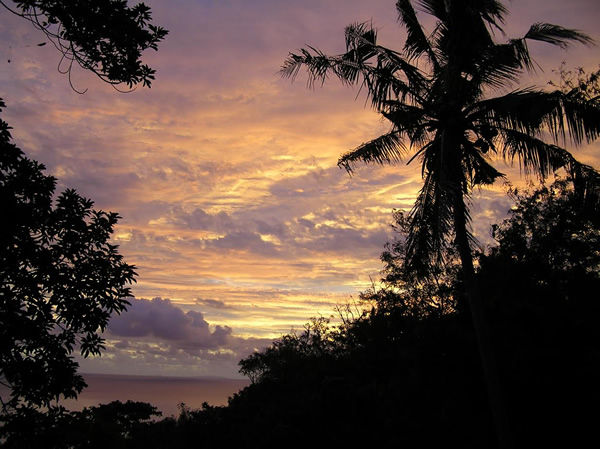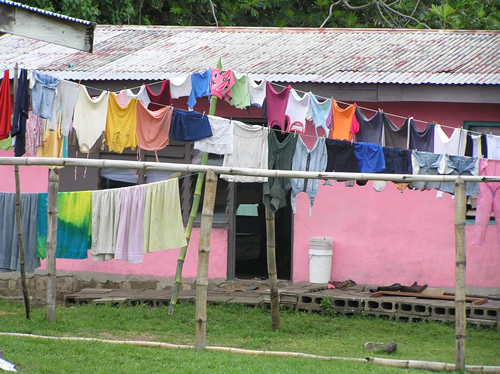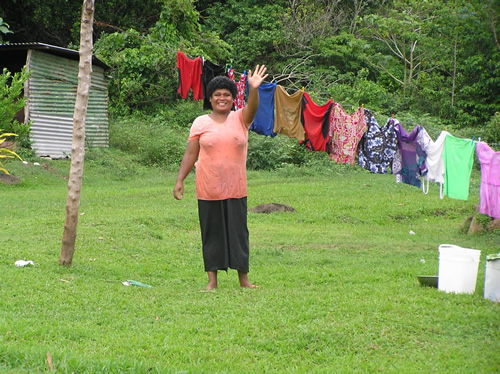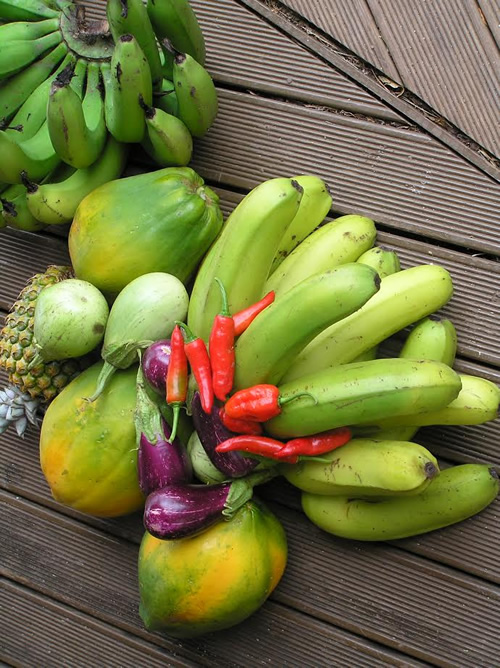Living Abroad in Fiji: The Sensual Rhythms of Native Life
Article and Photos by Caroline Cottom
 |
| Fiji at dusk. |
The deep island greens of the Fijian rainforest and palmy coast are muted at dusk, as though taking cover for the night. But the sky, aqua and fading, is lit with sun-filled puffs of clouds. Before us, these downy blossoms
seem to burst with light before turning apricot and mauve over the humps of the mountains.
Sunset is anticipated like a cousin who shows up each evening for dinner, but no two sunsets are alike. One evening a painted lady peeks from behind dense horizon clouds; on another, a cascade of brilliant beams drowns
the distant islands in light. Today from the road that circumscribes Koro Island, my husband and I watch as a gauzy curtain lifts suddenly to reveal deep orange to the line where sky meets sea. Awed, we pull over in our truck to take in the
show.
Over decades the coconut palms along the shore have turned scarlet in response to the sun and salt. Tonight their red-streaked brilliance seems to answer the sunset. The ocean is more alive at this hour than at any
other, as the colors of the sky bounce through the water like schools of iridescent fish.
On Koro Island, the expanse of sea and sky allows us to witness and be a part of the infinitesimal movements of daily and nightly transformation. This is the way most of Nature changes: so gradual that it is almost
imperceptible. Much of what we observe is the effect of the Earth’s rotation. Later, the arrival of Orion and his belt, and Orion’s measured movement across the night sky, will mark the Earth’s turning. It is a mirror of “Fiji time”: slow,
unhurried, evenly paced.
Returning home from the post office on the far side of the island, our truck jounces along the dirt road in the dimming light. Creaking and groaning, it carries us through eight Fijian villages as night approaches.
Houses are one room or two, made of wood or corrugated tin, painted turquoise and yellow and hibiscus pink. Outside, lines of brightly patterned clothes, like rags of bandana, waft in the breeze.

On the road Fijian men and women wave their bundles of taro, smile, and shout “Bula!" (Hello! Happy life!) and "Moce!" (Goodbye! Happy night!). In each village children joyfully yell out as we slow
down to exchange greetings. In our travels through Europe, North and South America, Russia, and New Zealand, we have not met a friendlier people.
We have left our comfortable home in Tennessee and traveled to Koro Island to help build a retreat center, knowing it means living simply — growing pumpkins and cassava, boiling our drinking water, hanging clothes out
to dry. At first primitive and savagely beautiful to us, Koro’s village life has become more familiar and attractive with each passing day.
On this small island, 5 miles wide by 10 miles long, life is familial, communal, joyful, humorous. Fijians walk everywhere — up into the hills to work their plantations; along the roads to gather bananas, mangos, and
breadfruit; from village to village for Saturday rugby games and night-time social gatherings.

Communal living means the villagers divvy out the bounty of an abundant papaya or lime tree. Many a tuna, walu, or red snapper caught by starlight is cooked alongside a pig in a lovo (an underground
oven made of wood and rock) and shared at a village meal. The villagers invite us to eat lovo on special occasions, serving up taro leaf cooked in coconut cream and other delicacies new to our western palates. We feel honored to be
invited in and bring the roots of yaqona, a plant of the pepper family, to offer respect.
Each village has a designated tree under which they pound the yaqona roots into powder, later to be mixed with water to make kava, the relaxing national drink. In most villages we pass tonight, a
designated convener pours water and powdered kava into a large wooden bowl, swishing the cloudy liquid with his hands. The kava is then poured into a cup made of coconut shell and passed among the men. After each round, the
men tell stories and jokes. The women, meanwhile, lean in the open doorways of their houses, relaxing with the children and sharing stories of their lives.
On this special night, we stop at Navaga village to perform sevusevu, a ceremony of respect offered to the village and the chief. Over time, we will perform sevusevu in each of the five villages
closest to the resort. Tonight on our trip around the island, we have purchased a waka, a tightly wound bundle of yaqona roots, to present to Navaga’s chief. Before emerging from the truck, we tie sulus, rectangles
of colored cloth, over pants and skirt. Fijians appreciate this show of respect, often commenting to others about our interest in honoring the cultural traditions.
"Mai, mai (Come, come),” says Samu, our pre-arranged spokesman, as we approach the chief’s house. Taking off our sandals, we follow Samu into the house – my husband first, as he carries the yaqona.
We join the chief’s spokesman and his younger brother, who sit on the floor, and await the chief, who is thought to be connected to the vu, the spirit of the land. The yaqona is a spiritual intermediary, as it comes from the
land and embodies the vu. In the sevusevu, the yaqona connects the mortals present with the vu.
The chief arrives, and the ceremony begins with Samu presenting the yaqona as a symbol of our wish to honor the traditions of the village. Samu notes that we are neighbors who have come to honor the chief,
the traditions, and the way of life. The chief’s spokesman receives the yaqona as a gift and offers a blessing. He says that the ceremony allows the mingling of our two people. Now we are part of their family and welcome to return
to the village at any time. At the end of the exchange, the Fijians say, “Dina! Dina!” (True! True!), acknowledging the ancestors and the vu for their presence in the ceremony. Sometimes a round of kava drinking follows
the sevusevu, but tonight the chief is tired so we shake hands and we go on our way.
Back on the road, we spot a white barn owl gliding in the deepening dusk, which reminds us we are living close to nature. Even the humorous moments — piglets squealing in the truck’s path, not smart enough to step into
the grass; their mother sows rooting in the mud of the local graveyard — are illuminating. We realize that the rhythms of native life bring peace and happiness to the faces we see. It is apparent that on Koro, nature and joy are intertwined.
Tonight, nearing the resort, we see the ferry crossing from Vanua Levu, Fiji’s second largest island. Affectionately called the “SOFI” (Spirit of Fiji Islands), the ferry looks like a gigantic insect with her strings
of pink, blue, and yellow lights, inching her way toward the Koro wharf. Now we know why large bulging sacks have been stashed along the road. The village trucks will soon pass through to pick up taro roots, yaqona, cassava, and other
produce from the plantations, to be loaded onto the SOFI on its way to market in Suva, Fiji’s capital.
As we turn up the drive to our house, the truck’s lights blare on hordes of frogs that stare blankly from the road. “Frogicide,” my husband jokes, as most frogs continue to sit and stare, destined to meet their Maker
under the wheels of our truck. Years ago a farmer introduced them to Fiji to control insects in the sugar cane fields, but they are poisonous to animals that eat them, so we are not too sad at their demise. At any rate, it is impossible to
warn them, so we say a frog prayer to bless them on their way.
All of nature is abundant in this garden paradise: morning glory vines that wrap themselves around vegetables, plants, and trees; insects that chirp, buzz, and tweak; bananas that grow in bunches of 60 to 100; red-breasted
musk parrots and flying fox bats that feast on the papaya trees at night. Coconuts, mangos, pineapples, passion fruit, guava, soursop pears — enough fruit to feed all of us on Koro and none would ever go hungry. Such bounty models a continual
cycle of giving: the tremendous energy of life that pulses through all of nature. It is the essence of the sevusevu as well — a cycle of giving and receiving respect.

Once, upon spotting a cow in the rainforest, miles from the closest village, I asked the resort manager, a Fijian, how the cow would find its way home.
"It is home,” he said.
Oh, I thought, so that’s how it works. On this island, everywhere is home, and everything belongs to everyone. The rhythms of sea and sky, of passion fruit and pigs, reveal a deeper truth: that everything is related
to everything.
Respecting Village Culture
in Fiji
Fijians value all efforts made by Westerners to honor their village traditions.
- Wave, smile, and call “Bula” when passing Fijians on the road. Friendliness is valued highly by Fijians, who will treat you like royalty if you are friendly.
- Drive slowly through villages and when passing Fijians on the road. Vehicles are scarce, domestic animals roam freely, and everyone is on foot in the village. Driving slowly allows you to greet the
people you pass.
- Dress modestly. When visiting villages, women should tie on a sulu as a skirt (the traditional Fijian version of a sarong). Shoulders should be covered, and necklines modest. If visiting
a chief or a church, men should wear long pants or a sulu, and a shirt. For other village visits, men may wear bermuda shorts and tee-shirt (no tank tops).
- Leave behind your sunglasses and hats, as dark glasses and hats are considered impolite.
- Participate in kava ceremonies. Yaqona preparation and drinking are the most honored feature of formal life. The pounding of roots into powder, blending with water, and consumption are
all part of the sacramental ritual that marks births, marriages, deaths, official visits, and all chiefly functions. Drunk in moderation, kava is a safe and relaxing drink. Villagers appreciate when Westerners participate in a round
or two of kava at village visits, special ceremonies, and traditional Fijian meals. If you decline to drink, which is permissible, do so respectfully.
- Offer a sevusevu . For those living near a village or working in many government and business settings, it is important to offer a sevusevu to the village chief or head of the agency or
business. The yaqona is typically carried by the head of the delegation, if there is one, or by the eldest male.
Resources on village culture:
- The tourist guidebook, Moon
Handbooks: Fiji, is an invaluable resource on the basics of Fijian culture. The
Straight Path of the Spirit describes traditions that precede the arrival of the Methodist Church in the mid-1800s. Many of these traditions are still alive in the villages.
- Much of what we know about Fijian culture we learned from Fijians and expatriates we met after we arrived in Fiji — neighbors Lai and Sova Tusega, Australian Alan Johnston, and others. Ask for guidance.
Fijians are pleased by your interest and eager to tell you about their culture.
|
Caroline Cottom, PhD, is the co-author of two books, The
Isle of Is: A Guide to Awakening and The Pen Is Mightier than the Broom:
Memoirs, Stories, and Poems.
|
